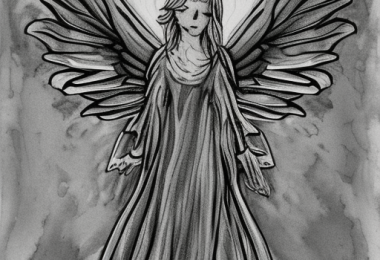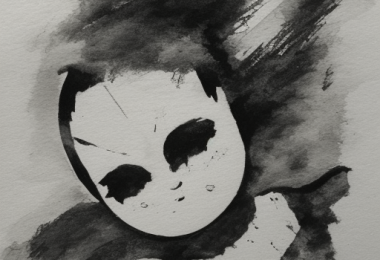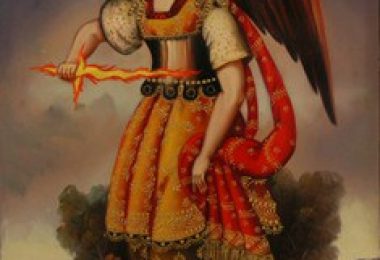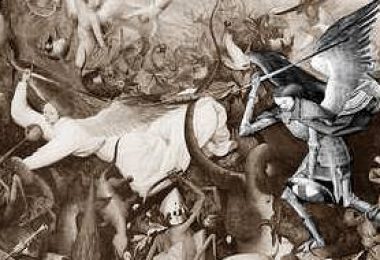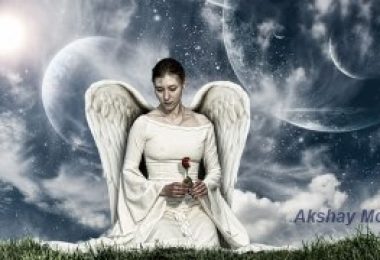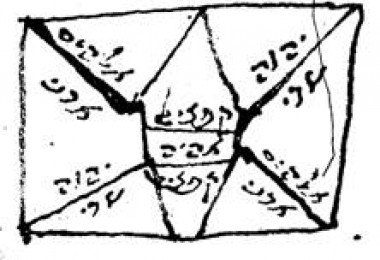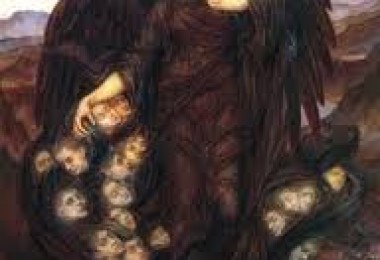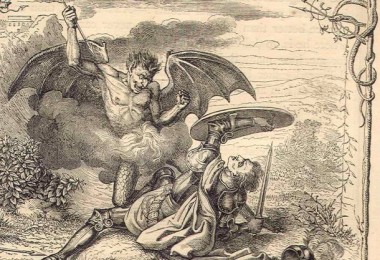The early Christians regarded some of the martyrs, such as Saint George and Saint Theodore, as military patrons; but to St Michael they gave the care of their sick and he was first venerated as a healer in Phrygia (modern-day Turkey).
The earliest and most famous sanctuary to Saint Michael in the ancient Near East was also associated with healing waters. It was the Michaelion built in the early 4th century by Emperor Constantine at Chalcedon, on the site of an earlier Temple called Sosthenion.
A painting of the Archangel slaying a serpent became a major art piece at the Michaelion after Constantine defeated Licinius near there in 324, eventually leading to the standard iconography of Archangel Michael as a warrior saint slaying a dragon. The Michaelion was a magnificent church and in time became a model for hundreds of other churches in Eastern Christianity which spread devotions to the Archangel.
In the 4th century, Saint Basil the Great’s homily (De Angelis) placed Saint Michael over all the angels. He was called “Archangel” because he is the prince of the other angels, the title Αρχαγγέλος (archangelos) being used of him in Jude 1:9. Into the 6th century, the view of Michael as a healer continued in Rome, when after a plague the sick slept at night in the church of Castel Sant’Angelo (dedicated to him for saving Rome), waiting for his manifestation.
In the 6th century the growth of devotions to the saint in the Western Church was manifested by the feasts dedicated to him, as recorded in the Leonine Sacramentary. The 7th century Gelasian Sacramentary included the feast “S. Michaelis Archangeli”, as did the 8th century Gregorian Sacramentary. Some of these documents refer to a no longer extant Basilica Archangeli on via Salaria in Rome.
The angelology of Pseudo-Dionysius which was widely read as of the 6th century gave Michael a rank in the celestial hierarchy. Later, in the 13th century, others such as Bonaventure believed that he is the prince of the Seraphim, the first of the nine angelic orders. According to Saint Thomas Aquinas (Summa Ia. 113.3), he is the Prince of the last and lowest choir, the Angels.
Catholicism
In the Roman Catholic teachings Saint Michael has four main roles or offices. His first role is the leader of the Army of God and the leader of heaven’s forces in their triumph over the powers of hell. He is viewed as the angelic model for the virtues of the spiritual warrior, with the conflict against evil at times viewed as the battle within.
In his fourth role, St Michael, the special patron of the Chosen People in the Old Testament, is also the guardian of the Church; it was thus not unusual for the angel to be revered by the military orders of knights during the Middle Ages. This role also extends to his being the patron saint of a number of cities and countries.
Roman Catholicism includes traditions such as the Prayer to Saint Michael which specifically asks for the faithful to be “defended” by the saint. The Chaplet of Saint Michael consists of nine salutations, one for each choir of angels.
Eastern and Oriental Orthodoxy
The Eastern Orthodox have always had strong devotions to angels, and the trend continues to date with the term “Bodiless Powers” applied to them. A number of feasts dedicated to Archangel Michael are celebrated by the Eastern Orthodox throughout the year.
Archangel Michael is mentioned in a number of Eastern Orthodox hymns and prayer, and his icons are widely used within Eastern Orthodox churches. In many Eastern Orthodox icons, Christ is accompanied by a number of angels, Michael being a predominant figure among them.
In Russia many monasteries, cathedrals, court and merchant churches are dedicated to the Chief Commander Michael, and most Russian cities have a church or chapel dedicated to the Archangel Michael.
The place of Michael in the Coptic Orthodox Church of Alexandria is as a saintly intercessor, where he is seen as the one who presents to God the prayers of the just, who accompanies the souls of the dead to heaven, who defeats the devil. He is celebrated liturgically on the 12th of each month. In Alexandria, a church was dedicated to him in the early fourth century on the 12th of the month of Ba’unah. On the 12th of the month of Hathor is the celebration of Michael’s appointment in heaven, where Michael became the chief of the angels.
Protestant views
Protestant denominations generally recognize only two archangels, Michael and Gabriel, usually emphasizing Michael, unlike Judaism, Roman Catholicism, and Eastern Orthodoxy which may at times recognize seven (and in rare cases eight) archangels, with Michael, Gabriel, and Raphael generally regarded with an elevated status, e.g. being the only archangels honored by name in Catholicism.
Citing Hengstenberg, John A. Lees, in International Standard Bible Encyclopedia, states: “The earlier Protestant scholars usually identified Michael with the pre-incarnate Christ, finding support for their view, not only in the juxtaposition of the ‘child’ and the archangel in Rev 12:1-17, but also in the attributes ascribed to him in Daniel.”Charles Haddon Spurgeon, a Trinitarian, stated that Jesus is Michael “the only Archangel”, and that he is God the Son, and co-equal to the Father. In Spurgeon’s view, “archangel” means “head of the angels” rather than “head angel,” and is a title similar to “Prince or Leader of the host.” (Daniel 8:11)
Within Anglicanism, Bishop Robert Clayton proposed that Michael was the Logos and Gabriel the Holy Spirit. Controversy over Clayton’s views led the government to order his prosecution, but he died before his scheduled examination.
Michael continues to be recognized among Protestants by key churches dedicated to him, e.g., St. Michaelis Church, Hamburg and St. Michael’s Church, Hildesheim, each of which is of the Lutheran Church and has appeared in the Bundesländer series of €2 commemorative coins for 2008 and 2014 respectively.
At Bach’s time, the annual feast of Michael and all the angels on 29 September was regularly celebrated with a festive service, for which Bach composed several cantatas, for example the chorale cantata Herr Gott, dich loben alle wir, BWV 130 in 1724, Es erhub sich ein Streit, BWV 19, in 1726 and Man singet mit Freuden vom Sieg, BWV 149, in 1728 or 1729.
Jehovah’s Witnesses
They believe the prominent roles assigned to Michael at Daniel 12:1 and Revelation 12:7, 19:14, 16, are identical to Jesus’ roles, being the one chosen to lead God’s people and as the one who “stands up”, identifying the two as the same spirit being. Because they identify Michael with Jesus, he is therefore considered the first and greatest of all God’s heavenly sons, God’s chief messenger, who takes the lead in vindicating God’s sovereignty, sanctifying his name, fighting the wicked forces of Satan and protecting God’s covenant people on earth. Jehovah’s Witnesses also identify Michael with the “Angel of the Lord” who led the Israelites in the wilderness.
Seventh-day Adventists
Seventh-day Adventists believe the name “Michael” is significant in showing who it is, just as “Immanuel” (which means “God with us”) is about who Jesus is. They believe that name “Michael” signifies “one who is God” and that as the “Archangel” or “chief or head of the angels” he led the angels and thus the statement in Revelation 12:7-9 identifies Jesus as Michael.
Seventh-day Adventists believe that “Michael” is but one of the many titles applied to the Son of God, the second person of the Godhead. According to Adventists, such a view does not in any way conflict with the belief in his full deity and eternal preexistence, nor does it in the least disparage his person and work. In support of the Seventh-day Adventist belief Michael is also the commander of God’s army which helped Joshua son of Nun to lead Israel in to conquering Jericho [Joshua 5:14 – “And he said, Nay; but as captain of the host of the LORD am I now come. And Joshua fell on his face to the earth, and did worship, and said unto him, What saith my Lord unto his servant?”]
In the Seventh-day Adventist view, the statement in some translations of 1 Thessalonians 4:13-18: “For the Lord himself shall descend from heaven, with a shout, with the voice of the archangel, and with the trump of God” identifies Jesus as Archangel, which is Michael. (Other translations have “For the Lord himself will descend from heaven with a cry of command, with the voice of an archangel, and with the sound of the trumpet of God.”) And the Seventh-day Adventists believe that John 5:25-29 also confirms that Jesus and Michael are the same.
Seventh-day Adventists believe there is and can only be one archangel and that one Archangel is named Michael and yet in Scripture is shown as doing what also applies to Christ even from the beginning, so is Christ preincarnate. There was a perception that Adventists were relegating Jesus to something less than divine or less than God but that is not valid since Seventh-day Adventism theology teaches and is expressly Trinitarian.
The Church of Jesus Christ of Latter-day Saints
Esoteric traditions
The French occultist, Eliphas Levi, the German philosopher Franz von Baader, and the Theosophist Louis Claude de St. Martin spoke of 1879 as the year in which Michael overcame the dragon. This is confirmed by the esoteric writer Rudolf Steiner in a lecture in Zurich on November 13, 1917, where he states: “in 1879, in November, a momentous event took place, a battle of the Powers of Darkness against the Powers of Light, ending in the image of Michael overcoming the Dragon”.
Islam
The Qur’an mentions Michael together with Gabriel in the sura Al-Baqara:
Whoever is an enemy to Allah and His angels and messengers, to Gabriel and Michael,- Lo! Allah is an enemy to those who reject Faith.
— Quran, sura 2 (Al-Baqara) ayat 97-98
In Sunni Islam, Michael will be sent to bring a handful of Earth, but the Earth will not want to yield a piece of itself, some of which will burn. This is articulated by Al-Tha’labi whose narrative states that God will tell Earth that some will obey him and others not.
The Ahmadiyya movement believes in Michael along with other angels such as Gabriel. They are called Mala’ikah and are described as spiritual beings who obey Allah’s command.

